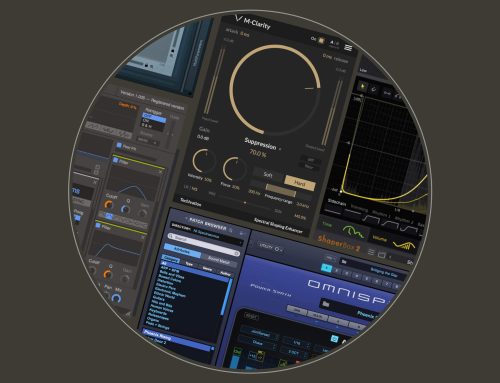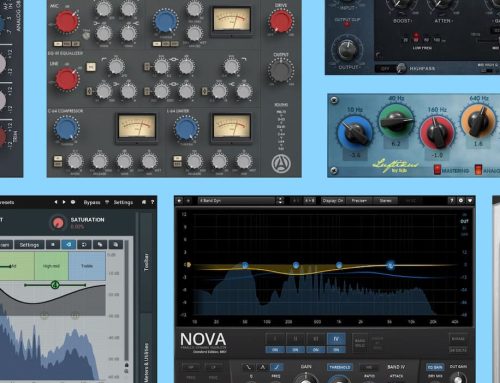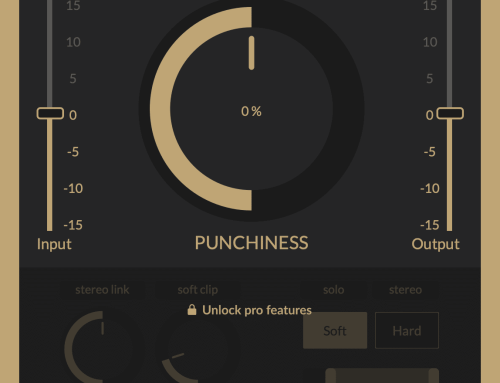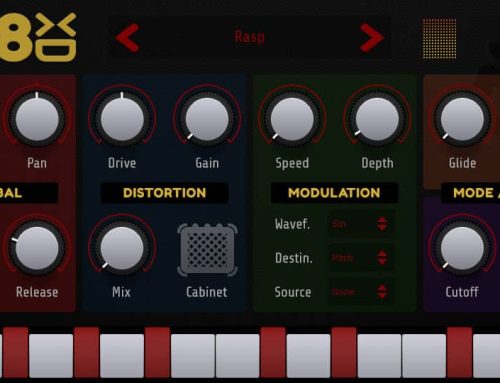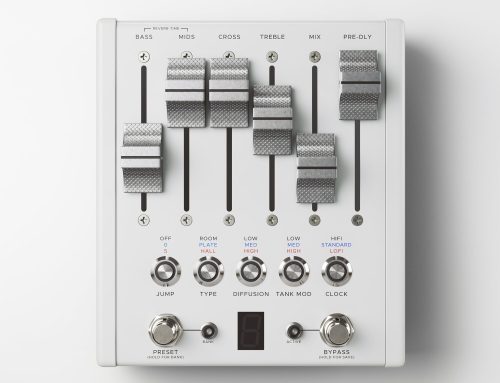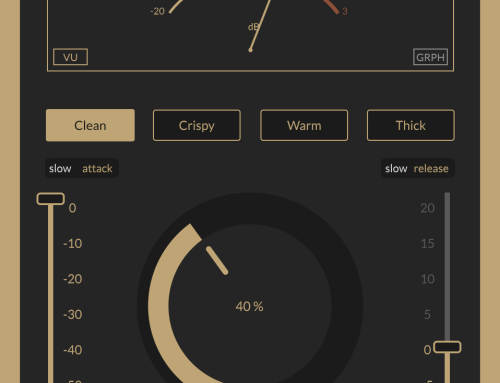The MP573 is yet another modern reincarnation of the legendary 1073 mic-pre circuit in a 500-series API format. It is made by the French company Sound Skulptor, led by Jean-Pierre Kuhn. The company was established as a manufacturing facility for the French recording studio and now school – Synchronia. Sound Skulptor have been manufacturing their take on the 1073 circuit for over 12 years now and the MP573 has had enough time to go through plenty of revisions.
In this review, we’ll examine what parts of the original circuit are responsible for the iconic “Neve” sound, whether or not they are to be found in the MP573, and how this unit performs against some of its rivals.
Layout & Controls
The preamp embodies the classic Neve 1073 look, but with Sound Skulptor’s spin on it. Starting at the top, we have a -10 to +10 dB Trim potentiometer, which instead of having a grey plastic knob, features a sturdy black aluminum knob. Below the Trim, there is a 6- position Gain knob (+10dB to +60dB), which in conjunction with the Trim can give us up to +70dB of maximum gain and plenty of fine-tuning capabilities.
The impedance switch has 3 settings – 300 Ohms, 1200 Ohms, and Line (10 kOhms, -26dB pad). The Polarity switch has 3 positions with the middle one being a “Mute”. That last one is an incredibly handy feature, which I didn’t know I needed before I used it as it prevents signal clipping when swapping mics in a busy session.
Lastly, we have a +48V red phantom power switch, a Hi-Z DI jack input, and an bi-color LED light indicating: normal level and clipping.
All the sturdy knobs and switches, the thick face-plate, and the overall weight of the unit scream high quality. The body of the MP573 includes: stainless steel back with cutouts for the ridiculously large output transformer and Gain switch relays, as well as a protective side-plate made from the same thick high-quality material used for its main PCB. Overall aesthetics, build, and premium materials throughout is a 10 out of 10.
Kit & Assembly
When we purchased the MP573 as a complete DIY kit, it came with all the necessary parts well laid out in individual bags. The packaging was substantial and included a bag of chocolates and a free bending tool for the resistors, transistors, and capacitors. That was a nice touch as it gave us a feeling that we’re buying the unit from our “mate” Jean and not from a money- hungry corporate.
The build itself was pretty straight forward and well documented in the instructions found on Sound Skulptor’s website, but even for an experienced solder, it took 5-6 hours to fully assemble and test. The main PCB and the mini PCB for the DI are both densely populated with components (at least in comparison to an API 512c) and feature plenty of tightly stacked vertical resistors. Anybody attempting the build should arm themselves with patience and willingness to work in tight places.
The 1073 Debate
Before we dive deep into the MP573 we should talk about what makes the 1073 circuit special and could it really be made nowadays. This hot topic has been debated for decades.
The purists out there will say that a true 1073 can only be a vintage module that has both a mic pre and an EQ section even though those old units would hardly sound like they did back in the 70s. After all, components wear out and for the period of 50 years, any unit would go through several serious services. Regardless of that, some of those vintage units still sound outstanding.
For those of us happy to settle with a more affordable modern take on 1073, that will at least sound “close” to the original – there are plenty of companies manufacturing this legendary circuit for all formats. AMS Neve and BAE offer some of the more favorable and expensive takes on it, but paradoxically many would claim the BAE line is truer to the originals whilst AMS have wandered off by changing components and methods.
Where does Sound Skulptor stand in this debate? They are making modern affordable 1073s, but are staying true to the original design by sourcing components with similar sound and performance to the vintage units. They also make a 1073-style EQ that connects to the MP573 via jumper cables and places itself before the output transformers of the preamp, just like the vintage modules.
The MP573 Circuit (tech-talk)
AMPLIFICATION
The challenging aspect of building a decent modern 1073 preamp is that the circuit relies on very few components so the choice of quality transformers, transistors, and other parts, is of utmost importance. To put things into perspective a single modern IC Op-amp consists of at least 20 transistors and some units are heavily populated with multiple ICs. The 1073 amplification topology however relies on 9 transistors in total, which in a way makes its whole circuit less complex than a single modern IC chip. At its core the circuit consists of two preamp stages (3 transistors each for Voltage Gain) and an amp stage (another 3 transistors for Current Gain). In this primitive yet ingenious simplicity lies one of the most sought after circuits in the world.
One of those amp transistors is the 2N3055, which would often have its own heat-sink. This is a crucial component to the sound of 1073s as it provides current to the output transformer. Here too the purists would disregard every new 1073 as the modern line of 2N3055-s isn’t quite like the vintage one.
Instead of having 3 amplification stages, the MP573 uses only two. The first one carries almost all of the work, whilst the second one kicks in only for higher gains. The only transistor Sound Skulptor took a detour with is the critical 2N3055, which they replaced with a smaller 2N6488 sitting in a mini heat-sink. We got in touch with the company and asked them why they’ve replaced this component knowing that it isn’t one of the expensive ones. Jean explained that this decision was not derived in hunger for greater profits, but in his mission to get closer to the vintage sound we all seek.
“The 2N6488 is a substitute to the original 2N3055. We find it closer to the 2N3055 of the 70’
than the current modern production.”
– Jean-Pierre Kuhn, Sound Skulptor
TRANSFORMERS

Transformers are a bit of a hot topic when it comes to 1073-s as too many people seem to focus their attention on them to justify the authenticity or quality of the circuit. Luckily, the MP573 has some of the most authentic transformer choices for a modern 1073.
As with all single-slot 500-series 1073-s, the limited space in the MP allows for only one input transformer, which in the case of the MP573 is a Carnhill VTB9045. Instead of routing the Line signal through a secondary one, the Line switch on the front plate activates a -26dB pad whilst passing the signal through the Mic transformer.
This is a clever design adopted by some of the most sophisticated clones including the ones from BAE and AMS.
VTB9045 Heritage
The input mic transformer used in the original vintage 1073s was made by Marinair back in 1970 (called 10468). Later on, Neve went to St. Ives to scale up production and was able to produce an exact copy of that transformer. After Marinair dropped out of the race, St. Ives became the sole manufacturer of the 10468 and in the mid-90s Carnhill took over. Luckily the new owner acquired not only the blueprints for St. Ives transformers but their location and production facilities. To this day Carnhill is still manufacturing the 10468 (under the name VTB9045) using the same wounding machines at the same location.
Today that modern 10468 can be found in several high-end 1073 clones, including the one from BAE & Sound Skulptor, but not from AMS.

Whilst the original vintage 1073s never used Carnhill output transformers, nowadays the company makes some of the most desirable choices on the market, which is why so many high-priced competitors of MP573 have adopted them. The usual choices include the VTB1148, VTB9049, or VTB1847 (used in the MP573). All of those 3 are electrically and sonically identical but have different packaging for the different mounting choices.
The VTB1847/iss2, found in the MP, is an enormous heavy iron-beast, which screams premium quality. Its width is almost larger than the whole 500-series module and can put a smile on the face of every gear-lover.
GAIN SWITCH

The Gain switch on 1073 is another crucial component and believe it or not it is one of the most expensive ones to replace in a modern unit. Whilst the original vintage Neves used dual-concentric multi-layered Elma switches, most reputable modern clones have moved on to Grayhill. The MP is no exception with its complex multi-pole gold-pin Grayhill switch which uses sealed relays found on the PCB for the different gain stages.
The only tradeoff of the MPs switch is that it moves in +10dB increments rather than +5dB like AMS & BAE or even +2.5dB (Heritage Audio).
That however has no impact on its sound, but rather the user experience. The sweepable Trim pot is an easy solution for fine-tuning the exact amount of gain, so we didn’t really feel a lack in this department.
Where Is The Catch?
So if the MP573 is equipped with some of the highest quality and most authentic Carnhill transformers, a gold-pin Grayhill switch, and all the necessary transistors, resistors, and even Tantalum capacitors, just like some of the premium modern 500-series 1073s, how is it so cheap and why can we get an MP573 for less than half the price of BAE’s 1073MPL or AMS’s 1073LB?
The answer is quite simple: the MP573 is not cheap at all. In fact, the internals cost just as much as the ones from the premium clones. The reason you and I can pay significantly less is that when bought as a DIY kit (370EUR) from Sound Skulptor’s website we are bypassing the costs for assembly & testing as well as the 50% markup of distributors and retailers. The equivalent would be buying a package of components straight from a BAE factory before anybody has put them together in a unit.
The fully assembled and tested preamp from Sound Skulptor costs 590EUR. If those units were to make their way to distributors and retailers the asking price would be closer to 1,000EUR.
So How Does It Sound?
We put the MP573 in our Bento10 500-series chassis and while we didn’t have any 1073s in the same format we did compare it to our AMS Neve 1073DPA on several sources.
The DPA is a modern stereo rack version of the 1073 preamp and aside from its 4 times higher asking price, it has the advantage over the MP with its dedicated built-in power-supply, Line input transformers, and a 3-stage amplification.
As expected the DPA ran significantly hotter than the MP, but other than that, the sonic differences were minor. So much so that it was hard to tell which unit was which. For some of the tests, we used signal-splitters and for some, we used matched pairs of microphones taped together, but we always recorded single performances.
On an acoustic guitar (recorded with a pair of Oktava MK012s) the MP seemed to have an ever so slightly pronounced bump around 200-300Hz when compared to the DPA. Now, whether the DPA is scooped or the MP is bumped I can’t tell you, but the difference is almost negligible. That was noticeable on other instruments so I decided to play the samples to a handful of engineers and see their reactions. Some said the DPA is a bit more “hyped” as the lows are tighter and the low-mid felt scooped in comparison to the more natural-sounding MP. Others thought the DPA was flat and MP573 is a touch “wooly” – 2 sides of the same coin.
Overall the MP had that classic Neve slowish gooey high-end transient smoothness, with rich and pronounced-enough low-end. I will restrain myself from saying “larger-than-life” as that is reserved for the vintage Neves, but both the MP and the DPA had some of that quality. The MP seemed 2% sharper with more natural transients, whist the DPA was ever so slightly slower, suggesting a more exaggerated smoothening effect. They both sounded silky and extremely musical, but the DPA seemed to have perhaps 2% more air and openness.
For a more realistic comparison, we decided to track a whole bunch of instruments, one at a time using both the DPA and the MP. This way we could potentially expose any accumulation of boomy or harsh buildups and we could hear how the mic preamps stack in a mix. The mics we used for all the instruments included Oktava MK012, Coles 4038, Shure Beta52, Sennheiser e901, whilst the bass guitar was recorded as a Direct In.
Here too the results were outstanding, with minimal differences between the 2 preamps.
On other tests, we decided to put both the MP and DPA into hotter regions so we could hear how they perform when driven. The DPA had that more familiar Neve-style drive where the mid-range got compressed and the top remained smooth even when overdriven, whist the MP became a bit more aggressive and gritty when its second amp stage kicked into gear.
The unique drive of vintage Neves or even some modern options like the DPA is what many engineers chase, but the reality is that without a serious console or another high-quality attenuation device after the preamp, that drive is unreachable for most engineers as A/D converters can’t handle the high input gain.
Verdict
The MP573 is an absolutely fantastic preamp with premium build, components, and performance. I would not hesitate to reach for it when I need the recognizable 1073 sound and I know the MP will deliver: high gain, large and thick bottom, smooth yet forward midrange and silky top-end every time.
This mic preamp is a great choice for just about any source and application. It is a perfect fit for home-based and budget studios as well as high-end projects.
If you are looking to expand your 500-series arsenal and you want that iconic 1073 sound – the MP573 will not disappoint. Sound Skulptor have stayed true to the original circuit probably as much as anybody can in 2021, whilst their asking price for the DIY kit is a no- brainer. The only con I can think of after buying and using the MP573 is that I didn’t get another 5 of them.



